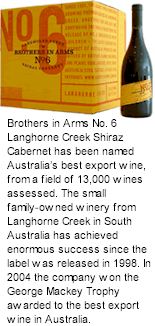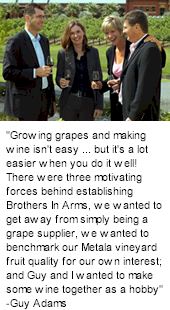


The vineyard comprises 750 acres of vines composed predominantly of Shiraz and Cabernet Sauvignon with a small area of Chardonnay. The Adams family have broad acre farming and merino sheep breeding for wool and meat production. Brother Guy Adams manages the Vineyard and supplies various wine companies with high quality fruit. Particularly Beringer Blass who produce the estate label Metala which has been made for over 40 years. Wine had been made in the stone cellars at Metala from the late 1890s and then in 1910, through family connections Stonyfell took over, still using the original open fermenters and cellars.

In 1952 production of the wine was moved to Stonyfell. Brian Dolan, winemaker at the time, conceived the idea of Metala becoming an estate wine and in 1959 sketched out the Metala label. Brian won the inaugural Jimmy Watson Trophy in 1962 with the 1961 Metala Shiraz Cabernet. Bryan’s son Nigel Dolan is now the Head Red Winemaker for Beringer Blass and continues the tradition of producing this iconic label. Aside from the big companies, Metala also provides fruit for a number if smaller boutique labels other than Brothers in Arms, such as Oddfellows and Killibinbin.
Brother Tom Adam’s decision to focus on a global market paid off but he has travel to the USA twice a year for up to 4 weeks at a time to meet key American industry people and to sell the brand name ‘Brothers in Arms’. He also works in the European market as well as around Australia. The brands success is because Tom is committed to marketing as the USA Grateful Palate owner says ‘he is a real salt of the earth kind of guy’ who gets results.
"Metala has been our family's property since the 1850s and it's also the name of the premium Beringer Blass label made entirely of our fruit. Our original plan, back in the early 1990s, was quite simple - grow the grapes, get a local processor to make the wine, then bottle it and sell it. We decided to select a single varietal as a flagship wine and focus wholeheartedly on it. Shiraz was the obvious choice as our Shiraz has always been fantastic.

"We started mucking around with small parcels of fruit with our father. At that time it was really just a hobby for us and it gave us something of our own to drink. In 1998 we took a small amount of fruit and turned it into 500 cases of Shiraz at Lake Breeze winery in Langhorne Creek. It was so bloody good that we didn't know what to do with it! We couldn't drink it all, so we started to think seriously about the future.
"Right around this time a pesky American came and knocked on my door. As it turned out it was Dan Phillips, a leading distributor from California, who was making regular trips to Australia looking for high-end lots of premium Shiraz - he felt there was going to be a market for it in the States.
"Somehow he picked up on us and he annoyed me so much that I gave him some unlabelled samples to test. He flew back to LA, phoned me four days later and told me to get a label on the rest as he could sell it! This led to our next problem as we didn't even have a name. I rang Ian Kidd, a designer in Adelaide, who came to Langhorne Creek and spent half a day with us. He came back with the Brothers In Arms label, and an awfully big bill, and we loved it.
"We released the 1998 vintage at Wine Australia in Melbourne in 2000 and it sold out within six weeks. We decided to make 4,500 cases for the 2000 vintage, but that was stretching the limits at Lake Breeze. We couldn't grow any further there so we decided to build our own winery at Metala. We started building in September/October 2001 and it was ready for a March 15 vintage in 2002 - this was no easy process. We love the wine and we know you will too."
